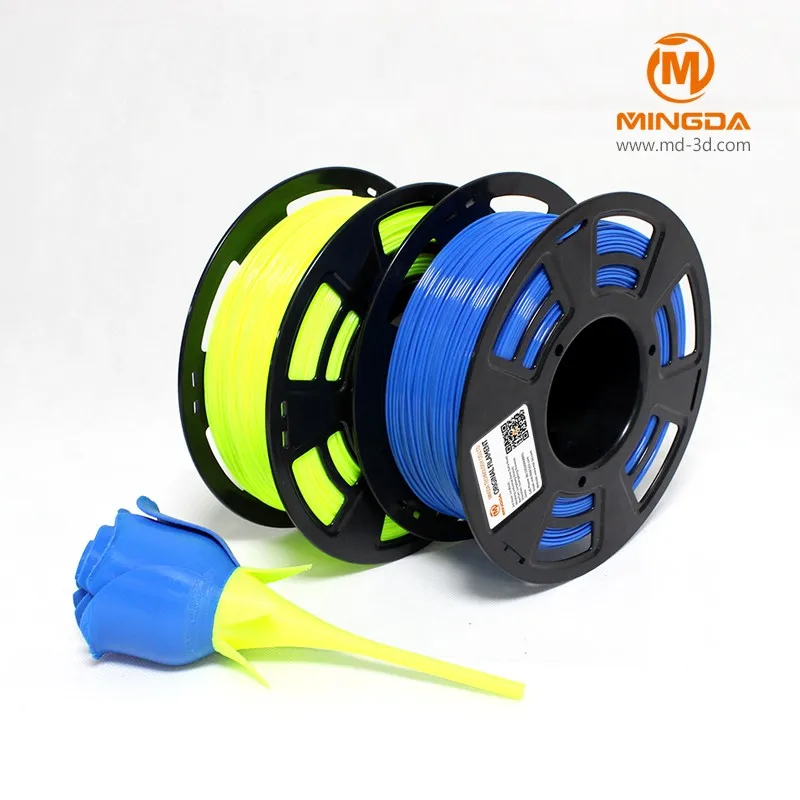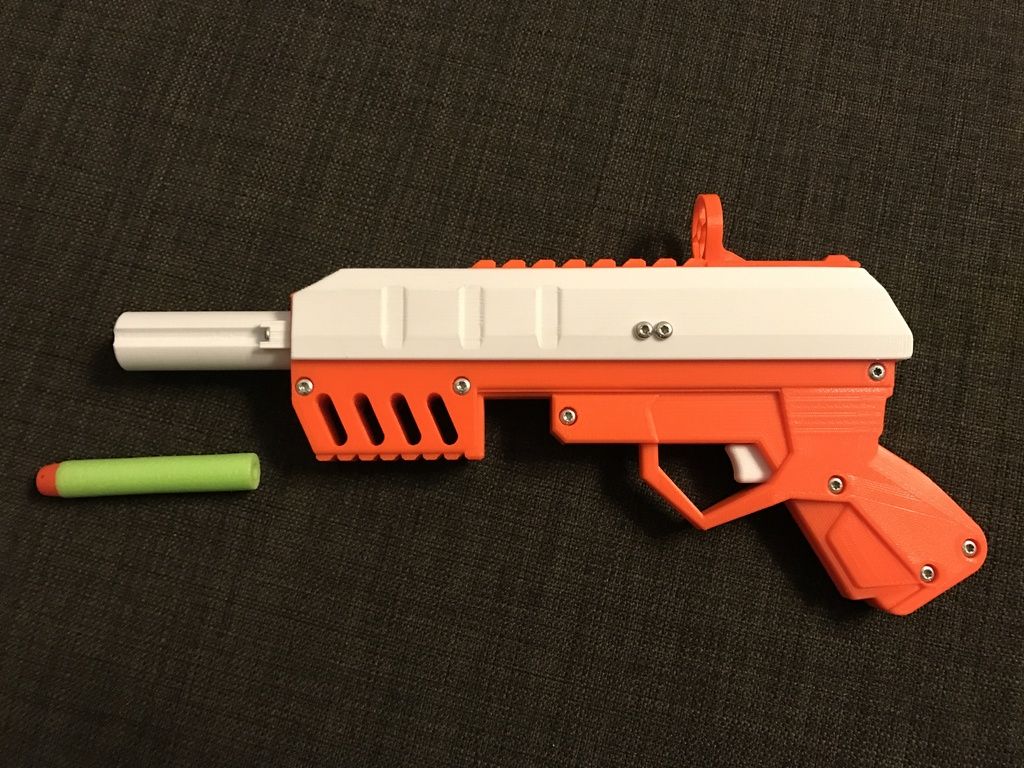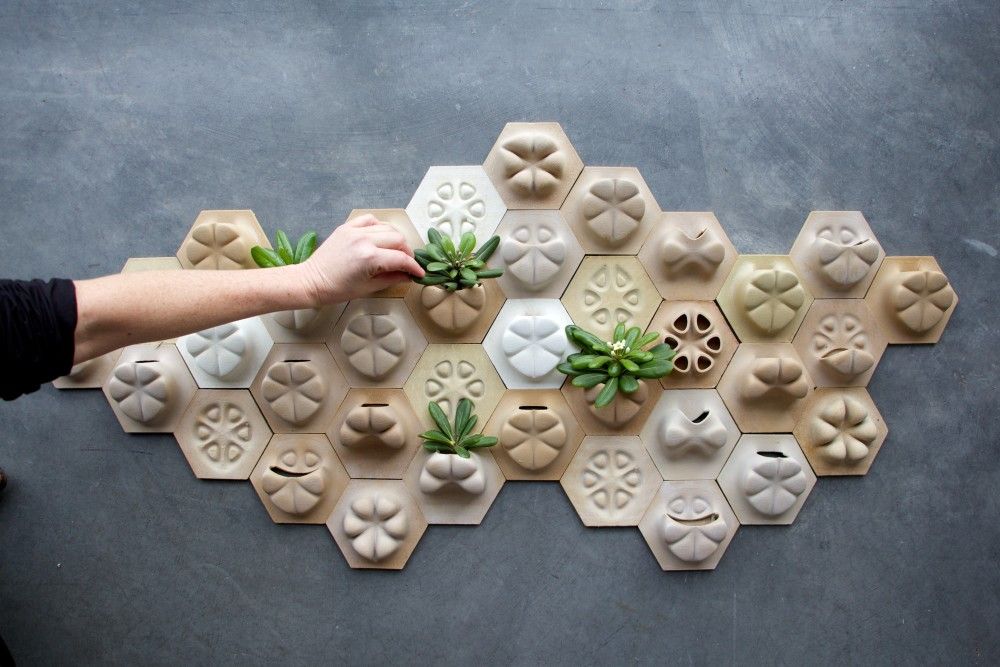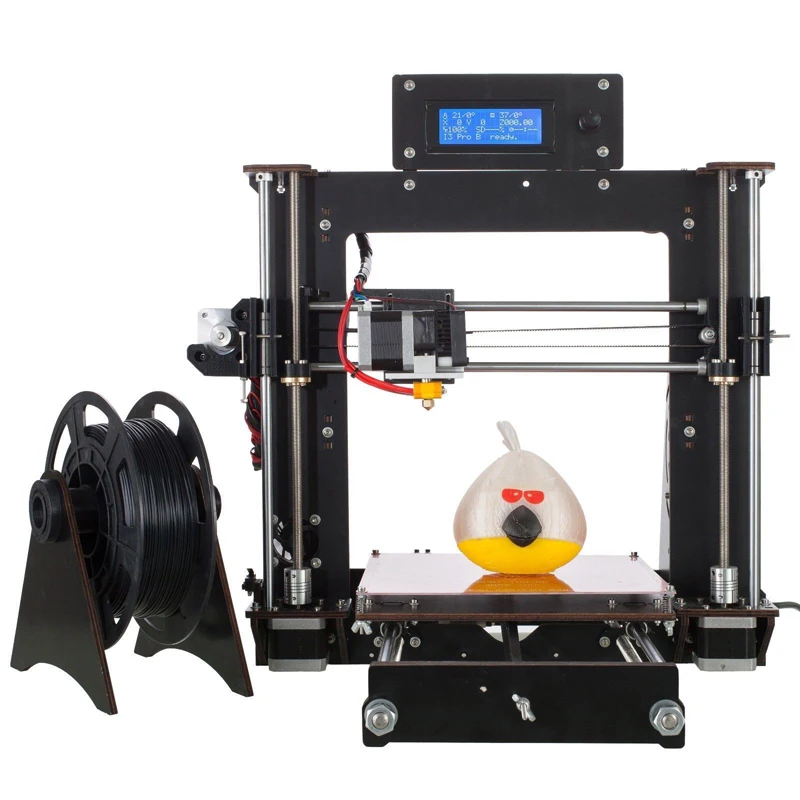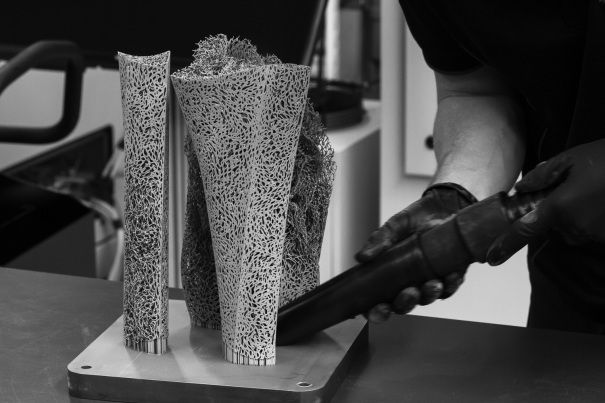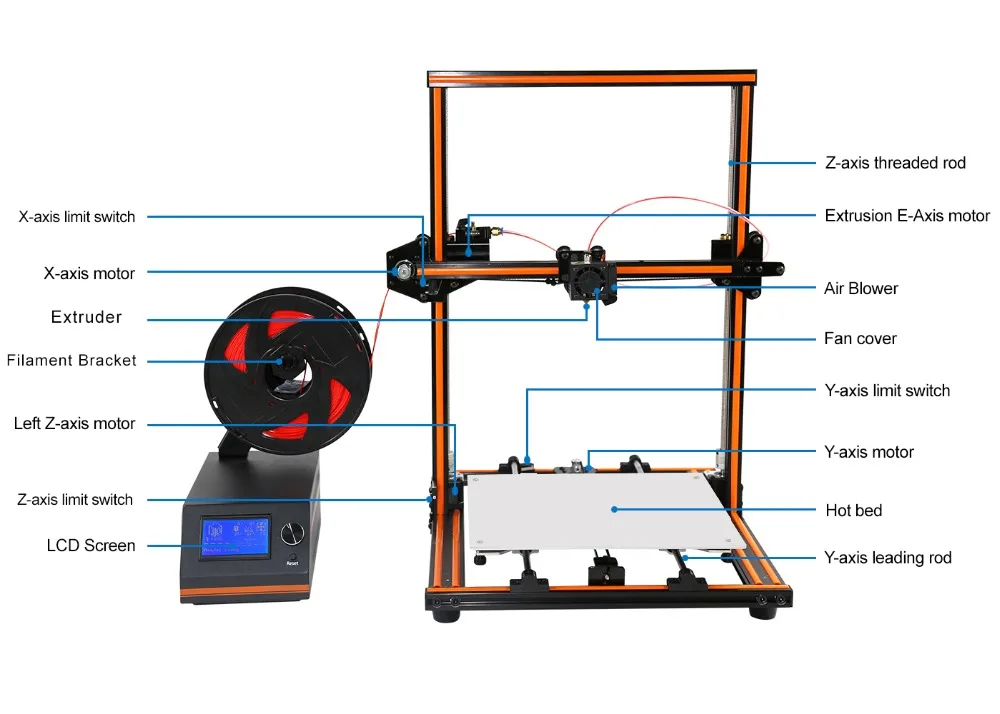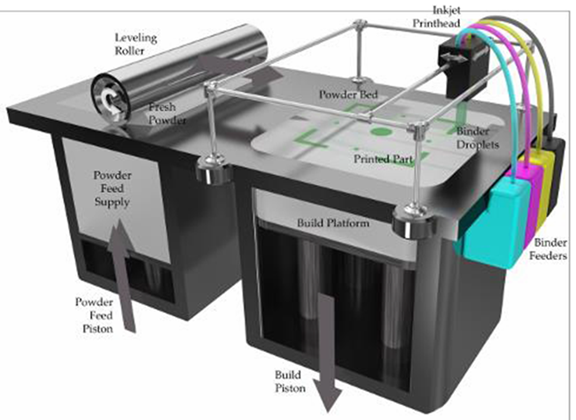3D printer pla food safe
Food-grade 3D printing: Is PLA Food-Safe?
Thanks to 3D printers, makers have the ability to bring any number of objects into existence, from missing hardware parts, to toys, to household items. But while the design freedom and capabilities of 3D printing may make it seem like you can make just about anything from the comfort of your home, it is important to understand what materials you are working with, especially if you are printing objects that will come into contact with food.
PLA (Polylactic acid) is a bioplastic material and is one of the most common 3D printing filaments available today. The plastic is derived from plants and is popular for its easy processing. Some of PLA filament’s benefits include that it prints at a lower temperature than many 3D printing materials, such as ABS, and it does not require a heated print bed. Because the material is made from natural materials, like corn starch and sugarcane, it is biodegradable and many assume it is food-safe. This can be true, but not in all cases. In this article, we answer the question “is PLA food-safe”, looking at what influences the material’s food safety and when to avoid food contact.
Recommended reading: PLA bed temperature & print temperature settings
What are the food-safe risks of PLA?
As a thermoplastic material, PLA is generally safe for food contact. In fact, a study from 1995 that put PLA material through several tests to determine how it breaks down found that it was “Generally Recognized As Safe (GRAS)” for food contact.[1] When it comes to 3D printing, however, there are other factors that can affect whether the material is safe to use in contact with food.
PLA Additives
In its purest form, PLA is food safe. However, if you are 3D printing with colored PLA filament, you should know that the additives used to dye the material may not be food safe. If you are 3D printing an object that will come into contact with food, like a mold or cookie cutter, it is safest to use natural (undyed) PLA filament. You can also consult the material information and safety data sheet for a particular filament brand to determine whether it contains any non-food-grade additives.
You can also consult the material information and safety data sheet for a particular filament brand to determine whether it contains any non-food-grade additives.
Non-food-safe printheads
Another element that can affect PLA’s food safety is the 3D printing process itself. In many cases, the metal hotend of the 3D printer is made from a non-food-grade material. That metal is continually coming into contact with the filament as it is extruded, which can lead to potentially dangerous contaminating traces in your 3D printed part. Brass nozzles, for instance, can contain lead and potentially leach toxic particles into 3D prints. If you are concerned about whether your hotend will affect the safety of your 3D print, you can always opt to use a stainless steel nozzle, which is considered food-safe.
Dyes and additives in PLA filament can influence whether the material is food-safe.
Bacteria contamination
Something else to be aware of is the fact that bacteria and germs can get stuck in and grow in 3D printed parts.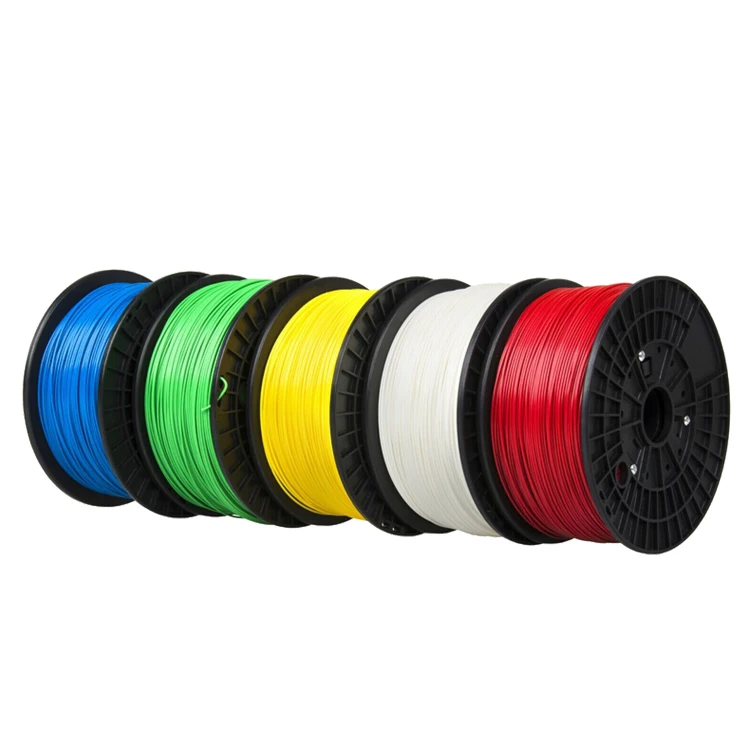 While they may look solid, FDM 3D printed parts have tiny pores in them that can trap moisture and provide a breeding ground for bacteria. If you do use a fresh 3D printed part to serve a snack, the pores can trap tiny particles of food, which can lead to potentially harmful bacteria growth. In terms of cleaning, it is difficult if not impossible to ensure that a PLA part has been properly sanitized for food contact once it has already come into contact with food. (The material is not very resistant to high temperatures and cannot be boiled or put in the dishwasher). This means it is safer to use a PLA utensil or plate once and then dispose of it.
While they may look solid, FDM 3D printed parts have tiny pores in them that can trap moisture and provide a breeding ground for bacteria. If you do use a fresh 3D printed part to serve a snack, the pores can trap tiny particles of food, which can lead to potentially harmful bacteria growth. In terms of cleaning, it is difficult if not impossible to ensure that a PLA part has been properly sanitized for food contact once it has already come into contact with food. (The material is not very resistant to high temperatures and cannot be boiled or put in the dishwasher). This means it is safer to use a PLA utensil or plate once and then dispose of it.
Finally, it is worth mentioning that your 3D printer should be thoroughly cleaned if you are printing objects for use with food. If you have previously 3D printed non-food-safe filaments such as ABS, there may be traces of the material in the 3D printer that can contaminate a PLA print and make it hazardous. This includes the print bed as well as internal 3D printer components, like extruders and hotends. Ideally, you would use a dedicated 3D printer to print food-safe PLA parts.
Ideally, you would use a dedicated 3D printer to print food-safe PLA parts.
Recommended reading: PLA Recycling: Can PLA 3D Printer Filament be Recycled?
Food-safe coatings for PLA
When 3D printing items that need to be food-safe, it is a good idea to err on the side of caution. One way to ensure that your PLA printed component is safe to use as kitchenware is to apply a food-safe coating or sealant. Epoxy resins are a common coating for 3D prints that will seal the surface. However, it is important that you find an epoxy resin that has been FDA certified as food-safe. You should also note that in liquid form epoxy resins contain toxic materials and must be handled with care (i.e. with gloves and mask). They are only safe when properly cured and hardened.
Another option is to use silicone as a food-safe coating. Silicone will seal the pores in the 3D print and result in a watertight surface finish. It is also less hazardous to use than epoxy resins. If you are aiming to make food-safe products that can be used safely over prolonged use, it is possible to 3D print a mold and cast it with food-grade silicone. There are also many examples of people 3D printing masters to make food-safe silicone molds. This is a great option if you want to make custom ice cubes, candies, or chocolates.[3]
If you are aiming to make food-safe products that can be used safely over prolonged use, it is possible to 3D print a mold and cast it with food-grade silicone. There are also many examples of people 3D printing masters to make food-safe silicone molds. This is a great option if you want to make custom ice cubes, candies, or chocolates.[3]
3D printer hotends can also leach potentially toxic chemicals into 3D printed PLA parts.
One disclaimer: a food-safe coating might wear down and degrade over time, so you should be wary of using your 3D printed kitchenware or food containers over the long-term. You should also read the fine print on the coating you are using: some are dishwasher safe and others are not and some are not suitable for use with hot foods or liquids.[2]
Recommended reading: PLA vs ABS: Which filament should one use?
Conclusion/Key Takeaways
Ultimately, as a pure material PLA is generally considered food-safe; there are no toxic chemicals in the polymer itself.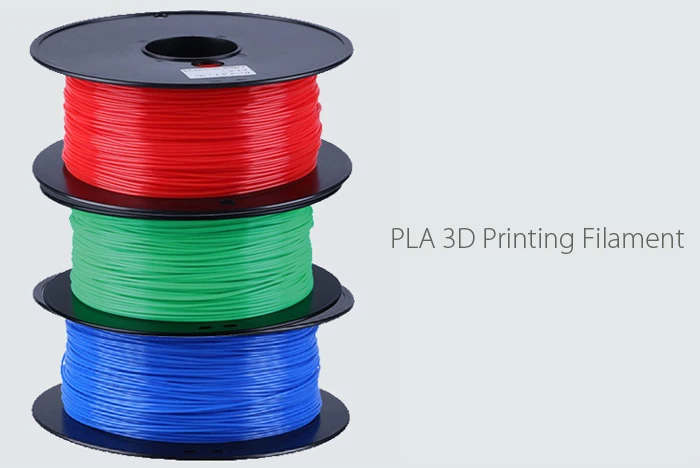 That being said, dyes or additives found in spools of PLA filament may not be food-safe. Other factors, like the 3D printer hotend material can also influence if a printed PLA part is safe to be used with food. Porosity in 3D printed objects can also lead to bacterial growth that can contaminate food.
That being said, dyes or additives found in spools of PLA filament may not be food-safe. Other factors, like the 3D printer hotend material can also influence if a printed PLA part is safe to be used with food. Porosity in 3D printed objects can also lead to bacterial growth that can contaminate food.
It is therefore generally safest to apply a food-safe coating to 3D printed kitchenware to avoid any potential health hazards or to use PLA prints as single use items. Other filaments, such as PETG, may also be considered safe for printing food containers. Ceramics are another category of food-safe material if treated properly.
References
[1] https://www.sciencedirect.com/science/article/abs/pii/027869159400145E
[2] https://formlabs.com/blog/guide-to-food-safe-3d-printing/
[3] https://www.instructables.com/GEEK-molds-for-every-home-1/
Food-safe 3D printing: Which materials are compatible?
3D Learning Hub
See all categories
Contents:
- Introduction
- Food 3D printing: Evolutions through the last decade
- Food safe 3D printing: Why it is so important?
- What are the food safe materials that you can use?
- Other tips for 3D printed objects food related
Introduction
Food 3D printing: Evolutions through the last decade
Over the last decade, the link between food and 3D printing became stronger and stronger.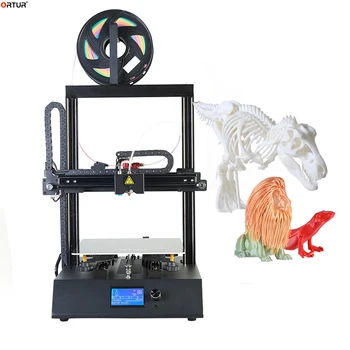 We saw it with the development of incredible food projects, such as Novameat’s 3D printed meat, many 3D printing chocolate projects like byflow, but also experiments of food printing made by NASA for astronauts. Even Barilla, the pasta company, developed a pasta 3D printer to work on the geometry of their pasta.
We saw it with the development of incredible food projects, such as Novameat’s 3D printed meat, many 3D printing chocolate projects like byflow, but also experiments of food printing made by NASA for astronauts. Even Barilla, the pasta company, developed a pasta 3D printer to work on the geometry of their pasta.
Researchers are pushing the limitations of 3D printing to create a variety of food using 3D printers.
But the relationship between food and 3D printing doesn’t stop there, as additive manufacturing can also be useful to print a variety of accessories for the food industry. Manufacturers can actually use 3D printers to implement more sustainability in their process, work on impressive shapes and geometries, to 3D print molds, prototypes or work on actual finished products.
Food safe 3D printing: Why it is so important?
Additive manufacturing for food
Yes, everything is 3D printable, and if it is possible to print impressive technical devices for the aerospace industry, it might also be possible to use a 3D printer to manufacture regular kitchen utensils for instance. You may want to create custom-made objects for kitchens. No matter what is your project, if there is a contact with food involved, the materials used have to be totally safe. First of all, it has to be safe for you, but also for the food in order to avoid food poisoning.
You may want to create custom-made objects for kitchens. No matter what is your project, if there is a contact with food involved, the materials used have to be totally safe. First of all, it has to be safe for you, but also for the food in order to avoid food poisoning.
To take another example, when 3D printing for medical purposes, you have to use biocompatible materials, that will be totally safe for the human body, that won’t be harmful to health. For any medical use, you have to choose your material wisely. It is the same for a gastronomical use.
The use of 3D printing tends to widespread in a lot of different industry. It is actually a great solution to make food containers but also more personal objects with a great design works and a custom-made aspect.
Mind the risks
Here are the main reasons why you need to use food-safe 3D printing materials or 3D printing filament:
Growth of bacteria
When 3D printing an object that will be in contact with food, the last thing that you want is the growth of bacteria that could eventually contaminate you or anybody else.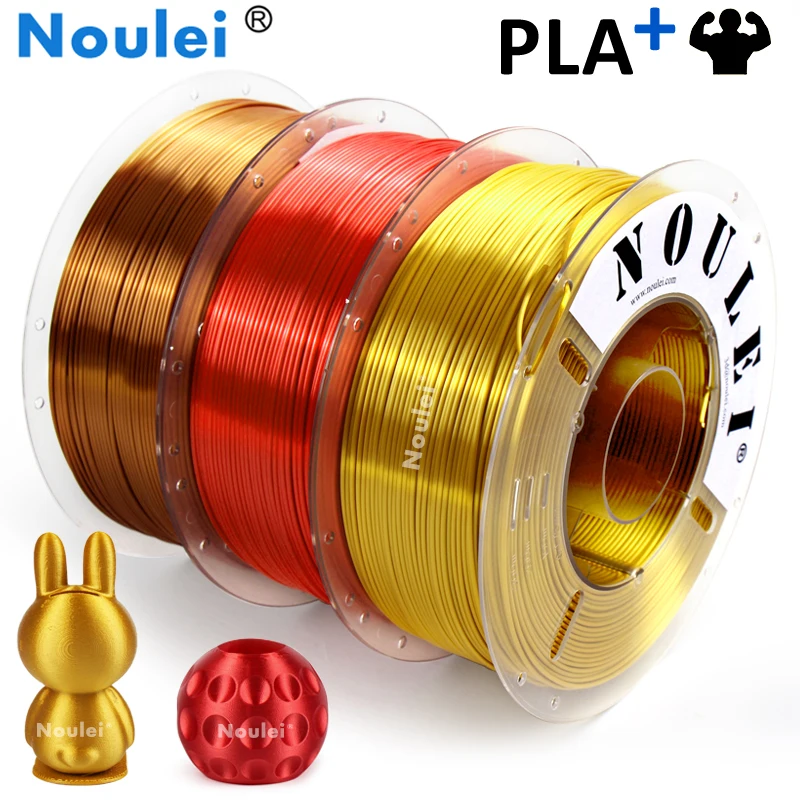 To avoid the growth of bacteria, you need a smooth material. And even if the object is quite smooth, you will have to pay attention to the design. Indeed, if the food can get stuck in small parts of your design, or simply in the layers, it will encourage the growth of bacteria.
To avoid the growth of bacteria, you need a smooth material. And even if the object is quite smooth, you will have to pay attention to the design. Indeed, if the food can get stuck in small parts of your design, or simply in the layers, it will encourage the growth of bacteria.
Chemical products from the printing process
A mix of heat and chemicals are actually needed to get a 3D printed objects, that is why you have to be careful on technologies and materials used to 3D print your project, especially if the part will eventually touch food. Toxic particles present during the 3D printing process could have health effect if ingested. It would a shame to be poisoned by a coffee cup!
Chemical directly in the materials
More than 3D printing processes, some materials are made of toxic chemicals ABS is particularly unsafe, as there are toxic chemicals in the filament! Some materials such as ABS have a high level of ultrafine particles, according to a study by Illinois Institute of Technology and the National Institute of Applied Sciences in Lyon, France. As the ingestion of these kinds of particles can lead to some health problem, we do not recommend you to use them. That is actually a factor that you have to take into account while 3D printing a part that will be in contact with food.
As the ingestion of these kinds of particles can lead to some health problem, we do not recommend you to use them. That is actually a factor that you have to take into account while 3D printing a part that will be in contact with food.
https://inhabitat.com/philippe-malouin-3d-prints-bowls-and-plates-using-sugar/
What are the food safe materials that you can use?
Choosing the right materials
Don’t be alarmed, 3D printing safely for food is completely possible, you just that you have to pay attention to the materials and 3D printing techniques that you want to use. Be careful: using a food-safe 3D printing material is great, but pay close attention to also use food-safe sealant if you need to assemble your parts to create your project. Here are a few examples of 3D printing materials that you can use to manufacture object in contact with food:
-
Ceramics
Ceramic is amazing to create food safe and resistant object, even using 3D printing.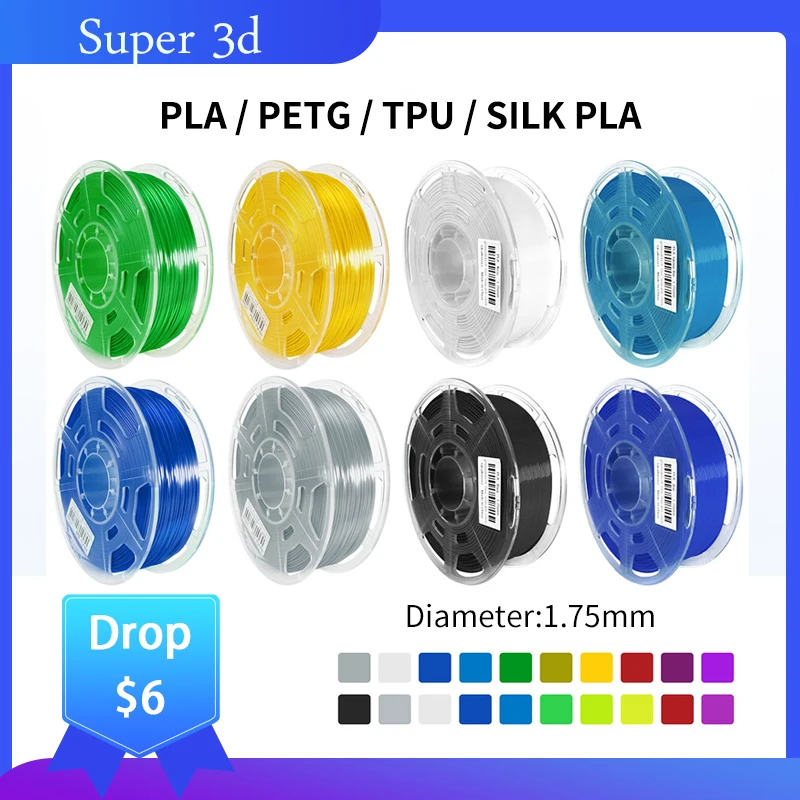 If you are looking for a food safe, watertight 3D printing part, think about using ceramic to manufacture it! Cups, plates or even saucers are 3D printable without any toxic chemicals. It might be the most coherent option to 3D print your items.
If you are looking for a food safe, watertight 3D printing part, think about using ceramic to manufacture it! Cups, plates or even saucers are 3D printable without any toxic chemicals. It might be the most coherent option to 3D print your items.
PLA is a 3D printing material that is safe for food contact. With plastic injection molding, this material is used to make packaging. It is a perfect material to 3D print project that will not be exposed to the heat of to a too powerful mechanical constraint. But if you want to create litte objects with this biodegradable plastic, such as cookie cutters, PLA filament seems to be a perfect choice.
PolyEthylene Terephthalate is a common material used to create plastic bottles or other classic food containers. It is known to be totally food safe! One of the main advantages of this material is that it can be totally recycled, often recycled at an industrial scale. To conclude, you can just create whatever you want, small parts to the whole 3D printed objects, but you just have to use a food safe filament or a food safe material. Obviously, it will be better for you, and for your customers!
Obviously, it will be better for you, and for your customers!
Other tips for 3D printed objects food related
What material will meet your expectations?
Choosing the right materials for your project can be a real puzzle. But once you’ve found it, it will really worth it. The choice of the material is essential, allowing your parts to meet perfectly your expectations and the expectation of your future customers. Regarding the properties of some materials, it could even improve the quality of the parts. Do you need a lightweight material? A resistant one?
https://medium.com/@3dhubs/how-kitchenware-startup-misen-used-3d-printing-to-develop-a-chef-s-knife-and-raise-over-1-million-6bece4506c94
Choosing the material that will resist a daily use
Indeed, aside from the food safety aspect, you have to use a material that will allow the object to be usable daily. Does your object need to be heat resistant? Will it be confronted with hot water, a microwave? It would be a shame to get a final object that could be deformed while exposed to warm water.
Moreover, you will certainly want to wash your parts if you are planning to use it with food. Can you wash this material? If you can’t put the object in the water to wash it, it could be quite complicated. Also, don’t forget to be sure that your object is dishwasher safe before putting it inside the machine!
We just told you about the materials that are considered safe for food. But there is also something that you don’t have to reflect: the food safe coating. Using food-safe materials is great, but using a food-safe coating with it, or no coating, is obviously better!
You have a question about food safe 3D printing and the food safe material? Don’t hesitate to contact our sales team to answer all your questions.
What foods could be 3D printed?
Can 3D printed food be eaten?
Related Topics
- Return to Top
Get the latest 3D printing news delivered right to your inbox
Subscribe to our weekly newsletter to hear about the latest 3D printing technologies, applications, materials, and software.
legislation, methods, materials and more
3D printing produces non-standard parts and complex shapes that are impossible or unprofitable to produce with traditional methods.
The benefits of 3D printing can be applied to a range of food-related products. For the use of printed products with foodstuffs, safety regulations and local laws must be observed. Failure to comply can lead to poisoning with toxic substances and the growth of harmful bacteria.
Food-safe materials are on the rise, making them easy to find. It is much more difficult to understand the legislation governing the production processes of food-safe 3D printing.
Learn about an introduction to food safety, the features of food-safe 3D printing, and how to produce it using standard technologies, including stereolithography (SLA), deposition modeling (FDM), and selective laser sintering (SLS).
Please note!
Formlabs polymers are not food safe without further processing.
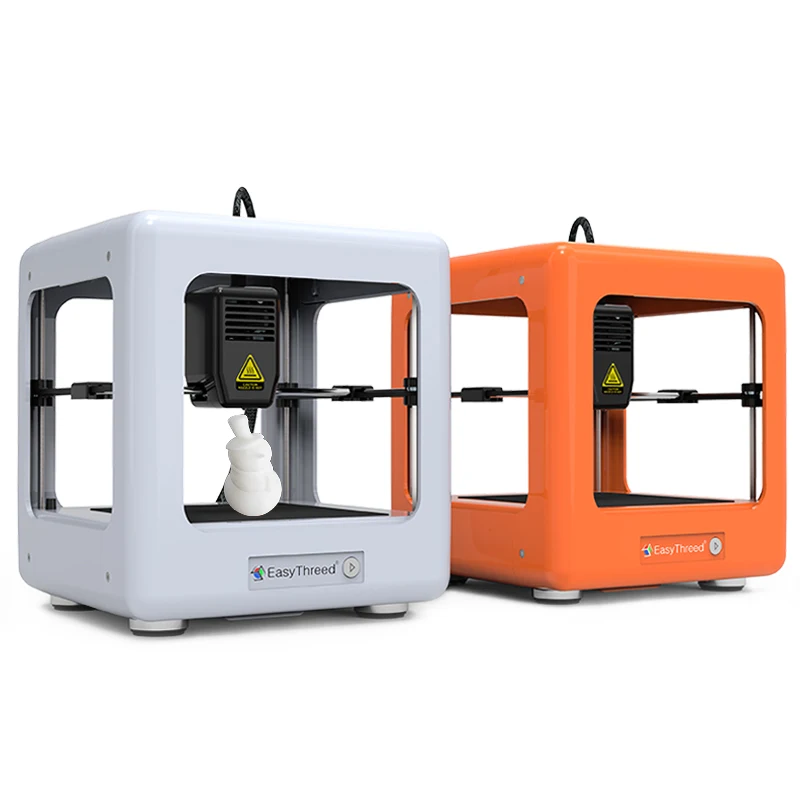
How-To Video
Can't find the 3D printing technology that best suits your needs? In this how-to video, we compare Fused Deposition Modeling (FDM), Stereolithography (SLA), and Selective Laser Sintering (SLS) technologies in terms of the top factors to consider when purchasing.
Watch video
It is important to clarify a few key terms:
- Food compatible material is safe for human consumption or approved for food contact.
- Food Safe material is suitable for food contact, meets the requirements of the intended use and does not pose a food safety hazard.
- To food contact surfaces refers to any surface that may come into direct contact with food. They must be made of non-toxic materials and withstand the conditions of their intended use, including exposure to cleaning compounds, disinfectants and washing.
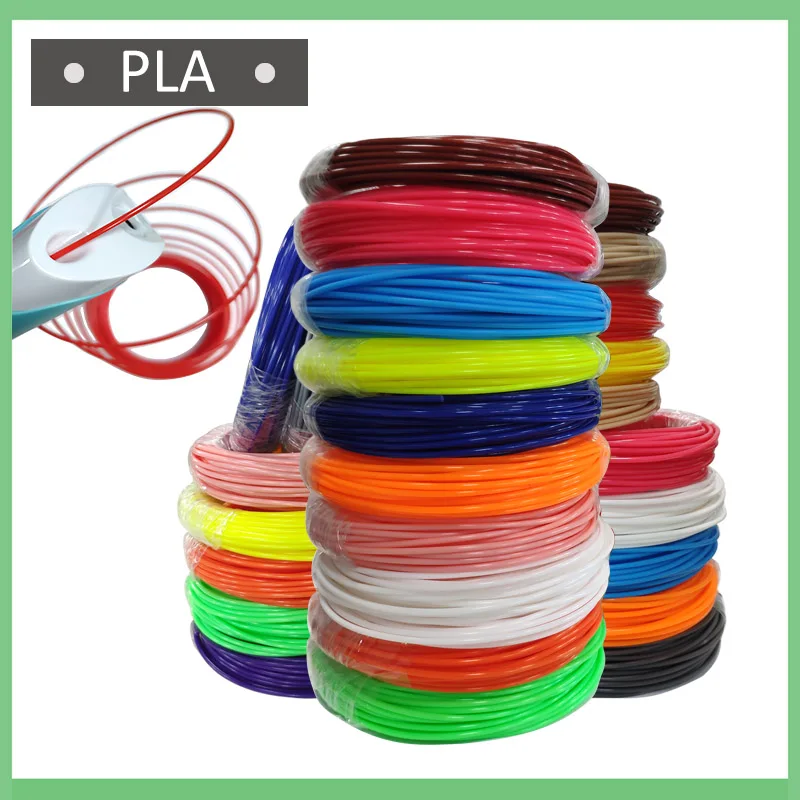
Food compatibility and food safety are related to migration, a specific way particles move. Every time the materials collide with each other, they exchange tiny particles, such as when a printed model comes into contact with food.
Migration through casual contact is low. Food compatibility is required when creating products that come into contact with food repeatedly, such as containers, straws, plates, and bakeware. Testing laboratories adhere to different approved lists of substances and acceptable risk levels depending on the state. Regulations in the US are set out in the US Food and Drug Administration (FDA CFR 21) and in the EU in EU regulation 10/2011.
If the product has been approved in the US or EU, it is labeled accordingly. "Conforming" to a material does not mean that it has been directly approved by institutions, so always check data sheets for certification.
Material is considered food safe by the US Food Code if it meets the following requirements:
- No Migration of Hazardous Substances
- Does not convey color, smell or taste
- Safe when used as directed
- Durable, corrosion resistant, non-hygroscopic
- Has enough weight to withstand repeated washing
- Has a smooth, easy-to-clean surface without kinks or sharp corners
- Resistant to rust, chipping, cracking, scratching and breaking
- Available for analysis
Any material approved by the US Food and Drug Administration (FDA) or the EU includes not only raw polymer, but also additives or concentrate.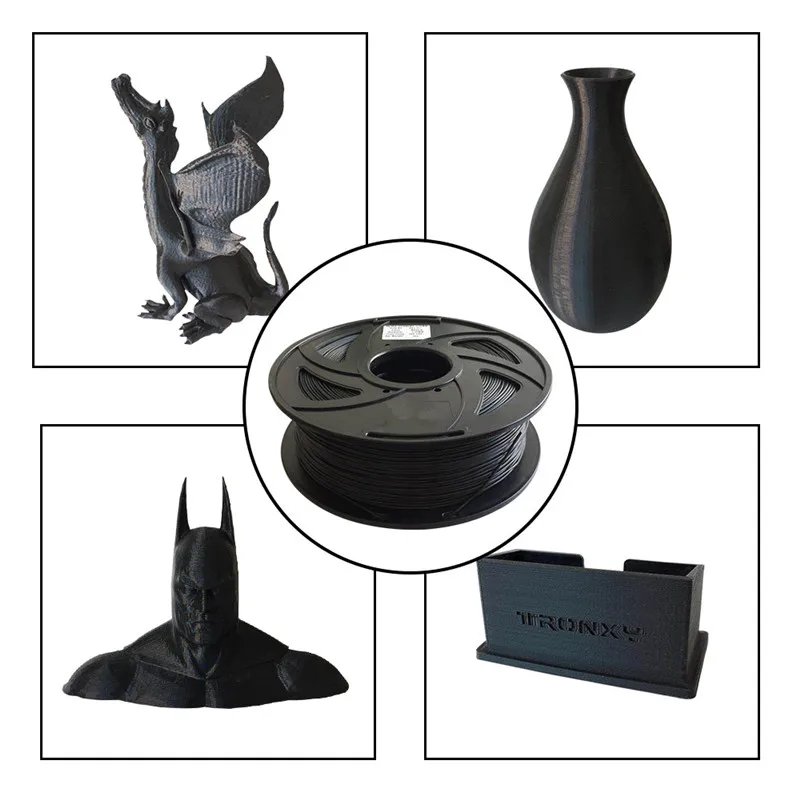 They may contain plasticizers, impact and heat distortion modifiers, UV stabilizers, flame retardants, antifouling, antistatic, anti-slip, foaming and clarifying agents, antioxidants, aromatic nucleators, carbon alloys, phosphorescents, fillers, thickeners, chain extenders, metal deactivators, dyes and polymer carrier.
They may contain plasticizers, impact and heat distortion modifiers, UV stabilizers, flame retardants, antifouling, antistatic, anti-slip, foaming and clarifying agents, antioxidants, aromatic nucleators, carbon alloys, phosphorescents, fillers, thickeners, chain extenders, metal deactivators, dyes and polymer carrier.
A 3D printed model can turn into a bacteria-infested Petri dish in a matter of weeks. E. coli and salmonella can hide in hard-to-reach places, such as folds and corners. Therefore, even a dishwasher cannot completely secure the printed model. Some toxic molds can grow on plastic surfaces and are resistant to treatment. Neither cleaning with bleach nor heating polymers in the microwave will get rid of germs.
Bacterial growth is not a problem for disposable items. But if you are planning to print products for long term use, we highly recommend using a food safe coating.
An effective way to combat particle migration and bacteria is to coat your 3D printed models with a food grade epoxy or polyurethane resin such as Masterbond EP42HT-2FG, ArtResin, or FDA approved polytetrafluoroethylene (Teflon®).
Please note that even the coating does not guarantee food safety for extended use of model . Not all coatings are dishwasher safe. In addition, they can wear out and expose the original surface.
Most 3D printing materials have a low heat distortion temperature. This means that they can crack or warp at high temperatures. Before washing, make sure that the material is resistant to the temperature of the dishwasher.
Particles can migrate from the surface of the 3D printer onto the model. Therefore, it is imperative that all components that come into contact with the 3D printed material or model are food-grade compatible and do not contain or release harmful chemicals.
Care must be taken when working with multiple materials, as previously used materials may leave toxic particles on printer components.
Many 3D printing materials are not food safe and may contain toxic chemicals. Use only materials that are certified food safe.
If the printed design is in contact with food for a long time, the risk of migration increases. Limit the time that unsafe materials come into contact with food and take precautions when making models that will come into contact with food for extended periods of time.
Think about the benefits of 3D printing for food contact applications. If you need to create custom shapes, you can use indirect 3D printing applications such as casting. See an example in the next section.
SLA 3D printing is based on photopolymerization, the process of curing liquid polymer into plastic using a laser. As a result, models printed with this method have the highest resolution, accuracy and surface quality compared to other technologies.
Is the polymer food safe? The answer is no. Substances can migrate from stereolithographic models, making polymers and printed products unsafe for food by default. Although some dental and medical polymers are certified biocompatible, this does not mean that they are food safe.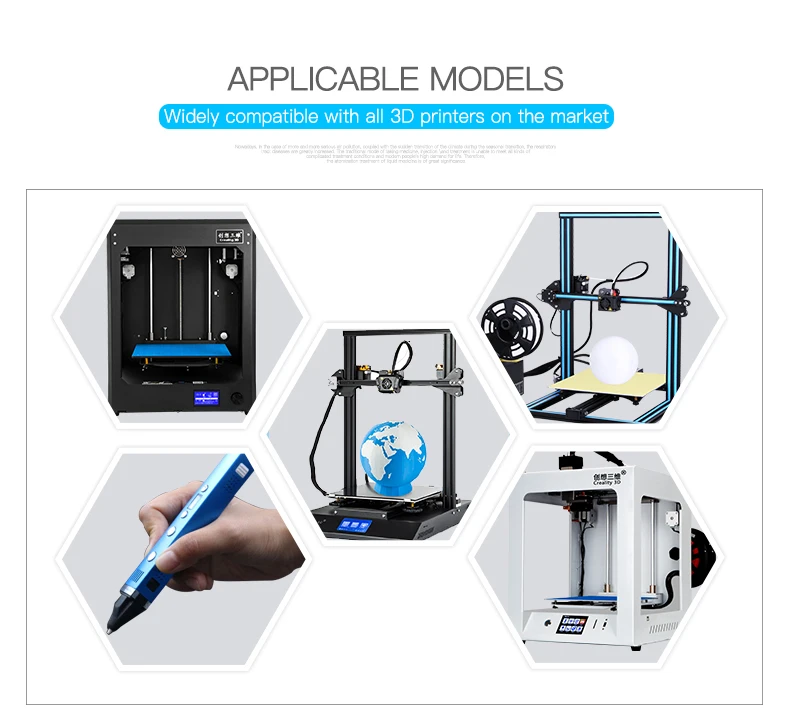 These materials are certified for a specific application and should not be used for food contact models.
These materials are certified for a specific application and should not be used for food contact models.
Stereolithographic models have a smooth surface that facilitates the application of coatings to seal and protect against bacteria. The smoothness of the surface depends on the resin, layer thickness, orientation relative to the build platform, mesh triangulation resolution, and polymerization profile of the SLA resin. Printed designs should be rinsed and cured according to the manufacturer's instructions prior to coating. Please note that coating does not guarantee food safety with prolonged use of the model, as over time it collapses to the original surface.
TECHNICAL REPORT
Looking for a high resolution 3D printer? Download our white paper to find out how stereolithography works and why it's the most popular 3D printing technology to create amazingly detailed models.
Download white paper
Creating custom molds is a common way to use SLA 3D printing to produce highly detailed models without direct food contact. Although stereolithographic models cannot be used for direct food contact, SLA 3D printers allow the creation of concave molds by vacuum forming using food-safe plastic.
Although stereolithographic models cannot be used for direct food contact, SLA 3D printers allow the creation of concave molds by vacuum forming using food-safe plastic.
Food mold printing tools and methods are simple and effective.
Printed thermoforming molds and silicone for a unique design.
Learn more about making vacuum forming molds in our detailed guide.
Galvanization is the process of coating models with metal using electric current. Usually this method is used for decorative purposes or to create a durable surface to protect the product from corrosion.
Stereolithographic models are ideal for galvanization due to their smooth surface. Plastic does not conduct electricity, so stereolithographic models must be made conductive. To do this, you can use graphite, conductive varnish, a plate with a chemical coating or sputtering.
You can also use food-safe metal coatings. But since the manufacturing process is associated with various chemicals, you will have to take care of the safety of food products.
Stereolithographic 3D printing allows the production of ceramic models. Once printed, they can be fired in an oven to burn out the resin and create a durable, heat-resistant ceramic pattern. Glazing makes models more hygienic and resistant to most chemicals.
Various food-safe glazes are available on the market. Be sure to follow the manufacturer's instructions and food safety regulations when using them.
Ceramic 3D printing is ideal for making complex geometries that cannot be done by hand.
Learn more about ceramics
Sample
Experience Formlabs print quality for yourself. We will send a free print sample directly to your office.
Request a Free Sample
Fused Deposition Modeling (FDM) is a method of creating models by melting and extruding a thermoplastic filament, which is deposited layer by layer with a printer nozzle.
The extruded material has a round cross-section which leaves narrow gaps between the layers.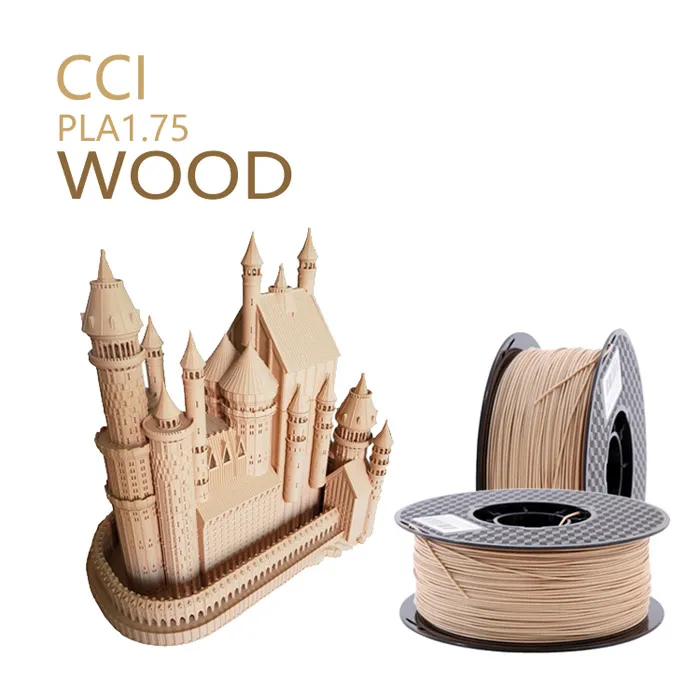 Their depth is directly proportional to the height of the layer. When printing food-safe models, it is recommended to use the lowest layer height possible.
Their depth is directly proportional to the height of the layer. When printing food-safe models, it is recommended to use the lowest layer height possible.
The main challenge when printing with deposition modeling is avoiding the growth of bacteria. A model with a smooth surface is considered truly safe for prolonged contact with food. Chemical polishing with solvents such as acetone, D-limonene or ethyl acetate gives the surface a glossy finish. However, a subsequent application of a food-safe coating is recommended.
Layers printed with deposition modeling (left) and SLA (right).
Food-grade filaments do not wear the nozzle when printing because they do not contain composite particles. Do not use brass nozzles containing lead. For products in contact with food, choose special nozzles made of stainless steel.
Always check the compatibility of the 3D printer components with the filament. For example, polyetherimide, a US Food and Drug Administration-compliant material, must be processed at temperatures above 300°C.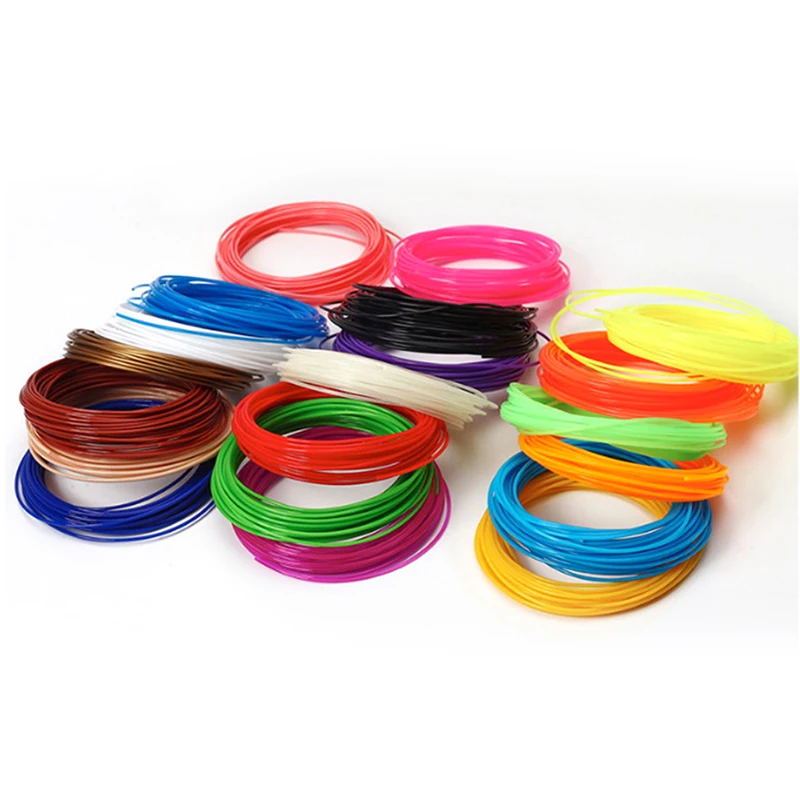 This feature is not available on all printers.
This feature is not available on all printers.
Two materials are the most frequently asked questions about the safety of food products printed by fusing modeling. Is PLA food safe? Is ABS food safe? The answer is that it depends on some conditions.
Food-safe threads contain PLA, PP, copolyester, PET, PETG, high-impact polystyrene, nylon-6, and some types of ABS, ASA, and PEI. The need to wash the model in the dishwasher eliminates PET, nylon and PLA because they soften and deform at 60-70°C. If the model will be exposed to high temperatures, it is better to use copolyester, PLA-HT or PEI.
Some studies indicate the potential harm of these substances, although this is not reflected in the legislation. It is suggested that polystyrene can release styrenes, copolyester is unhealthy, and food-safe filaments become toxic due to oxidation and thermal degradation during the printing process.
| Thread | Grade | FDA (US) | EU | Polish | Dishwasher resistant Selective laser sintering (SLS) 3D printers use a high power laser to sinter fine polymer powder particles. Some SLS powders are considered food safe, but the particles on the surface of the models may not be fully sintered. In this case, the surface remains porous and vulnerable to moisture and mold. Although Nylon 12 Powder can be steam autoclaved, we recommend coating the model with food safe coatings to protect the surface. Staining is an integral part of the post-processing of SLS models. Please note that paint may penetrate the inside of the model. In this case, it will become unsafe for food. TECHNICAL REPORT Looking for a 3D printer to create durable, functional models? Download our white paper to learn how selective laser sintering (SLS) technology works and why it is popular in 3D printing for functional prototypes and end-to-end products. use. Download white paper 3D food safety is not an easy topic. For more information on food safety and 3D printing, we recommend reading:
comparison of PLA, ABS, PET/PETG, HIPS, PP, ASA, nGen, PC-ABS, Flex, nylon and composites - qbed
3D printing filaments on spools There are several types of plastics on the market for FDM printing, each of which has its own advantages and disadvantages, is used to print certain models and requires different printer settings before printing. This article will focus on the key and most popular consumables for desktop FDM printing.
Article content: PLA
PLAAbout the material PLA (polylactic acid, or polylactide) is the most widely used filament. The disadvantage of PLA is its brittleness — PLA printouts are easy to break. And the low melting point of this material means low heat resistance - PLA printouts are not recommended to be exposed to temperatures above 60 °C. In combination with 's biodegradability of and 's modest UV resistance of , polylactide's low melting point hinders the use and storage of PLA prints outdoors and in direct sunlight. Also, post-processing PLA is quite tricky : you need chemicals like chloroform or hot benzene to dissolve this plastic. The minimum layer height of recommended when printing PLA is 50 microns .
Where is PLA used?PLA is most commonly used for printing concept models, prototypes, low wear toys, etc. Although PLA is biodegradable, it is safe to store food and drink in it, eating and drinking from PLA items however, it is not recommended, as bacteria can accumulate in the recesses on the surface of the printout. To avoid this, you can treat your printouts with a food-safe coating.
Prusa printer settings for printing from PLABefore printing from PLA, warm up the printer to the following values:
Settings may vary as each material manufacturer produces a slightly different PLA filament. Don't forget to experiment with the print settings in your printer and print and compare samples with different print settings! Back to content
ABSAbout the material ABS (acrylonitrile butadiene styrene, or acrylonitrile butadiene styrene) is a very strong and versatile material with high temperature resistance. Like PLA, this plastic is a thermoplastic polymer that can be repeatedly melted and crystallized without any visible damage to its properties. One significant difference between ABS and PLA is that ABS requires a higher temperature to melt, but it is this high melting temperature that gives ABS prints higher thermal resistance (your printouts will withstand temperatures up to 98°C). Another advantage of ABS is its solubility in acetone. If you want to give your printouts a smooth surface instead of the typical ribbed surface with distinct layers found in FDM printing, you can easily do this with ABS by treating the printouts with acetone vapor . Also surface treatment with acetone will allow you to join together different printouts and their parts. PLA plastic solvents are much less harmless than acetone, so post-processing with PLA prints is much more difficult. ABS contains wear-resistant synthetic rubber , which makes the material quite strong and impact resistant. Now a few words about the shortcomings. ABS plastic suffers from shrinkage on cooling. That is, your printout may shrink when temperatures drop, break away from the print platform (even when it is heated to 100 ° C) and deform, which, of course, negatively affects the quality of the printout. Another disadvantage of ABS is an unpleasant smell when melted. The printer must be kept in a well-ventilated area or come up with some kind of isolation chamber for it.
Where is ABS used?ABS is used where print strength is important. ABS is much stronger than PLA. ABS should also be preferred if you will be storing printouts outdoors or at high temperatures. ABS is often used to create architectural and concept models, spare parts (e.g. car interiors), smartphone cases, etc.
Prusa printer settings for printing from ABSBefore printing from ABS, warm up the printer to the following values:
Settings may vary as each material manufacturer produces a slightly different ABS filament. Don't forget to experiment with the print settings in your printer and print and compare samples with different print settings!
Back to content
PET/PETGAbout the material PETG (polyethylene terephthalate glycol) - very strong material with good thermal resistance and strong layer bonding. Prints made from this material can be used and stored both indoors and outdoors. When printing from PETG, there is practically no deformation of model , so this material can be safely used for printing large objects. Also PETG is quite elastic material , which reduces the risk of model breakage under pressure. Glycol is often added to PET during production (hence the G in the name), which makes the material easier to use when printing, less brittle, and makes the translucent varieties of the material more transparent and clear. One of the properties of PETG is 's low thermal expansion, which reduces the chance of prints coming off the platform and deforming during printing, so there is no need to use isolation chambers as is the case with ABS. Now about the cons. Unlike PLA or ABS, PETG tends to will bleed out of the extruder in unwanted places and may leave unwanted strands of plastic on the printout. To solve this problem, you need to experiment with the temperature settings of the extruder and / or increase the retraction, and the finished printout itself can be quickly heated with a hot air gun. PETG, like PLA, does not dissolve with acetone , which complicates post-processing. PETG printouts can be easily scratched .
Where is PET/PETG used?PETG is widely used for printing mechanical parts and other objects where strength is of great importance.
Prusa printer settings for printing from PET/PETGBefore printing from PET/PETG, warm up the printer to the following values:
Settings may vary as each material manufacturer produces a slightly different PET/PETG filament. Back to content
HIPSAbout the materialHIPS is a high strength plastic with high temperature resistance. It is easy to use and behaves like ABS when printed. But like ABS, HIPS produces an unpleasant odor when heated , and models made of this material when cooled can deform and lag behind the platform. HIPS - versatile and durable material that produces smooth layers. Dissolves HIPS using limonene.
Where is HIPS used?HIPS is suitable for printing mechanical parts and producing heat-resistant objects. HIPS is also widely used to create toys, packaging, signage.
Prusa printer settings for printing from HIPSBefore printing from HIPS, warm up the printer to the following values:
Settings may vary as each material manufacturer makes a slightly different HIPS filament. Don't forget to experiment with the print settings in your printer and print and compare samples with different print settings! Back to content
PPAbout the materialPP (polypropylene, or polypropylene) is an elastic and strong material with excellent physical and mechanical characteristics, which produces strong and durable objects. PP - physiologically inert material which may come into contact with foodstuffs. PP products are used in food factories, kitchens, bakeries, etc. A huge minus of PP is, like ABS with HIPS, shrinkage during cooling and deformation of printouts. The solution to the problem is to create an isolation chamber for printing for the printer, which maintains a high temperature.
Where is PP used?PP is used to create heat resistant and durable objects.
Prusa printer settings for printing from PPBefore printing from PP, warm up the printer to the following values:
Settings may vary as each material manufacturer makes a slightly different PP filament. Don't forget to experiment with the print settings in your printer and print and compare samples with different print settings! Back to content
ASAAbout the material ASA (acrylonitrile-styrene-acryl) is very similar in properties to ABS. Its main advantages over ABS are 's increased UV and weather resistance of and 's dimensional stability of printouts. ASA retains the gloss, color and mechanical properties of when stored and used outdoors. Like ABS, the disadvantages of ASA are an unpleasant odor during pyrolysis and curling of printouts when cooled. ASA may be slightly hygroscopic - It is recommended to dry the material before printing.
Where is the ASA used?ASA is widely used for the production of mechanical parts. Its weather resistance makes it suitable for printing vehicle exteriors, outdoor furniture parts and signage.
Prusa printer settings for printing from ASABefore printing from ASA, warm up the printer to the following values:
Settings may vary as each material manufacturer produces slightly different ASA heads. Don't forget to experiment with the print settings in your printer and print and compare samples with different print settings! Back to content
nGenAbout material nGen is a low styrene material developed by colorFabb based on Eastman Amphora™ AM3300 3D polymer. This material has several advantages: the almost complete absence of an unpleasant odor during pyrolysis , and the high heat resistance of (almost 2 times more heat resistant than PLA), and the dimensional stability of printouts created from it. nGen allows to obtain a stable flow of material even at lower extruder temperatures than other polymers, and allows you to work with more than over a wide temperature range , producing consistent quality and durable printouts.
Where is nGen used?Due to the unique combination of nGen's relatively low thermal decomposition temperatures with its high thermal stability, the material is used to create functional, durable and heat resistant products. nGen can produce prints with a beautiful gloss finish.
Prusa printer settings for printing from nGenBefore printing from nGen, warm up the printer to the following values:
Don't forget to experiment with your printer's print settings and print and compare samples with different print settings! Back to content
PC-ABSAbout the materialPC-ABS (polycarbonate ABS, or polycarbonate ABS) - is an improved version of traditional ABS plastic. Compared to classic ABS, this material is easier to process and has greater strength, stiffness and heat resistance. PC-ABS printouts feature sharp details and excellent surface quality.
Where is PC-ABS used?PC-ABS is often used to create durable plastic parts such as TV and computer frames, as well as to create functional prototypes and fixtures. This thermoplastic is often used in small-scale production. Engineers and designers use PC-ABS for power tool prototyping, industrial equipment manufacturing and other demanding tasks. Because of its strength and heat resistance, PC-ABS is ideal for printing appliance cases, handles, connectors, fans and turbines.
Prusa printer settings for printing from PC-ABSBefore printing from PC-ABS, warm up the printer to the following values:
Settings may vary as each material manufacturer produces slightly different PC-ABS heads. Don't forget to experiment with the print settings in your printer and print and compare samples with different print settings! Back to content
FlexAbout material Flex - very strong and elastic material. Flex printout does not shrink much when cooled , so it is convenient to print high-precision models from it. It is recommended to print slowly from Flex.
Where is Flex used?Flex is great for printing flexible objects such as phone cases, action camera housings or RC car wheels. FLEX is used for both rapid prototyping and small-scale production of finished products.
Prusa printer settings for printing from FlexBefore printing from Flex, warm up the printer to the following values:
Settings may vary as each material manufacturer produces a slightly different Flex. Don't forget to experiment with the print settings in your printer and print and compare samples with different print settings! Back to content
NylonAbout the material Nylon is a material with high wear and heat resistance. Like ABS, nylon can warp and warp when cooled unevenly , so printing with nylon involves having a heated bed at the printer, printing in warm rooms, or even building a closed chamber for the printer to maintain a high temperature (as well as printing from most of the materials listed in this article). nylon parts are almost impossible to glue together nylon, making it difficult to create large models from multiple prints. Nylon is highly hygroscopic , which means it easily absorbs moisture. It is recommended to dry the nylon filament before printing, so that the possible release of water vapor from the nylon does not damage your printouts. Taulman is the most popular nylon filament for desktop 3D printers.
Where is nylon used?Nylon has a high coefficient of slip and is widely used in bearings and similar machinery, often without the use of lubrication.
Prusa printer settings for printing from nylonBefore printing from nylon, warm up the printer to the following values:
Settings may vary as each material manufacturer produces slightly different nylon. Don't forget to experiment with the print settings in your printer and print and compare samples with different print settings! Back to content
CompositesAbout Composites There is a wide variety of 3D printing composites available, from metal simulants such as bronze and copper, wood simulants, sandstone simulants, glow-in-the-dark materials, as well as carbon and aramid composites. Sandstone and wood simulants are very easy to use when printing. Printouts from such materials are almost not subject to deformation , therefore, these composites can be printed without a heated platform. Different extruder temperatures allow you to achieve different shades of the material when printing with wood imitators: the higher the temperature, the darker the material becomes. And when printing with simulant sandstone, the temperature of the extruder sets the texture of the surface: the lower the temperature, the smoother the printouts, while the higher temperature will create a rough surface. Composites are highly machined, - sanded, drilled, etc. - and are easy to color. Composites tend to be very abrasive (with the exception of wood composites) and can easily scratch and damage the extruder if used frequently. The solution is to print with a high-strength nozzle. When printing with wood composites (0.5 mm and above), it is recommended to use a large nozzle. Another disadvantage is that composites are rather expensive material.
Where are composites used? Composites are used to achieve certain visual characteristics of the printout. If you want to create something that looks like wood or metal, or get glow-in-the-dark printouts, then composites are just right for you.
Prusa printer settings for printing from compositesBefore printing from composites, warm up the printer to the following values:
Settings may vary as each material manufacturer produces slightly different composites. |
|---|


 The most common material for selective laser sintering is nylon, a popular engineering thermoplastic with excellent mechanical properties.
The most common material for selective laser sintering is nylon, a popular engineering thermoplastic with excellent mechanical properties. 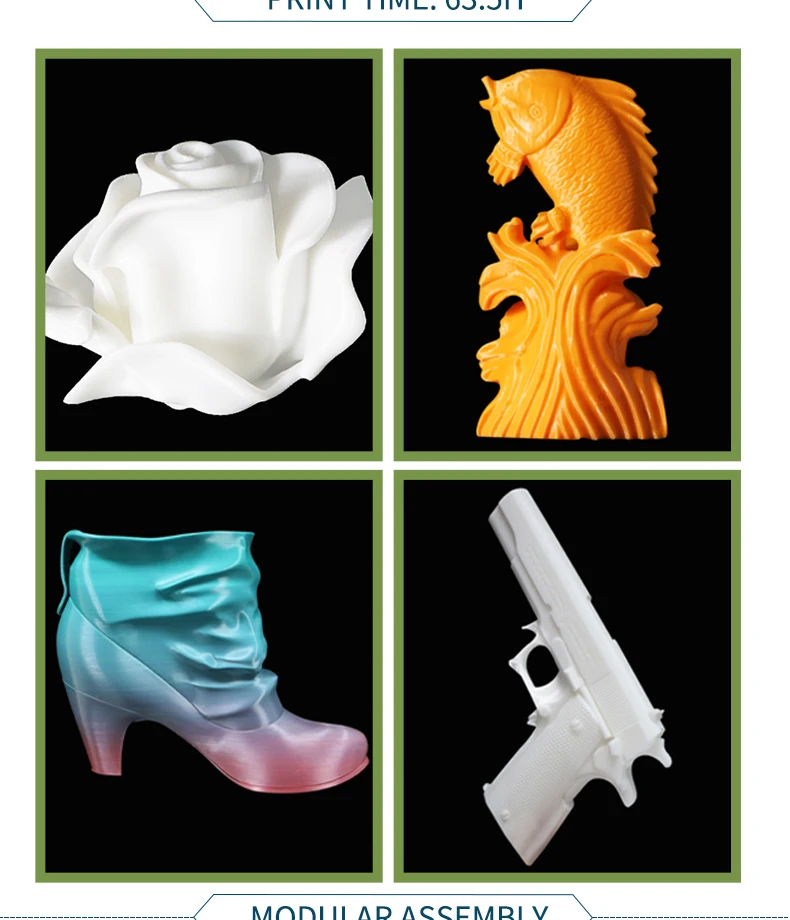 Printing food contact models requires careful consideration of risks depending on the intended use.
Printing food contact models requires careful consideration of risks depending on the intended use. 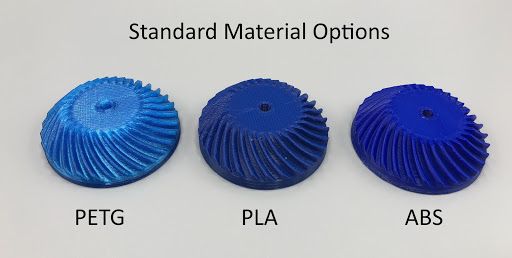
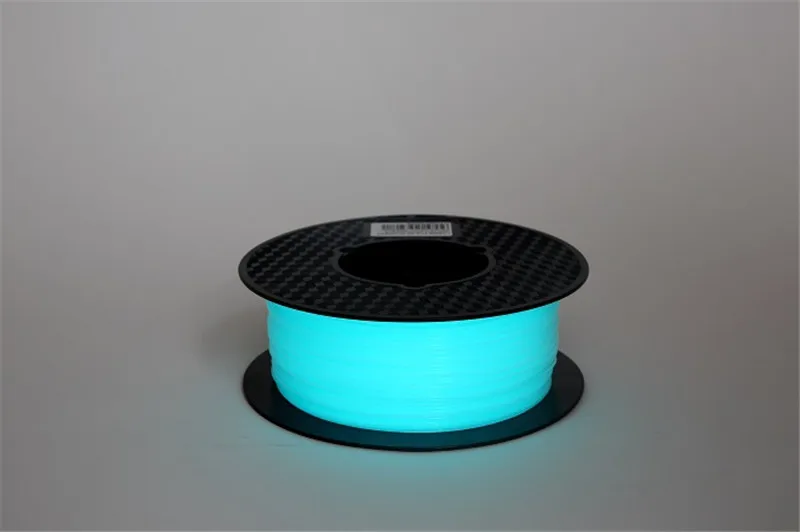 Its main advantages are ease of use, strength, biodegradability and versatility of (the low level of thermal expansion of plastic allows printing large models with little or no deformation, and the low melting temperature of about 175 ° C allows printing small objects). Like ABS plastic, which will be discussed below, PLA can be repeatedly melt and crystallize without pronounced deterioration of the material properties.
Its main advantages are ease of use, strength, biodegradability and versatility of (the low level of thermal expansion of plastic allows printing large models with little or no deformation, and the low melting temperature of about 175 ° C allows printing small objects). Like ABS plastic, which will be discussed below, PLA can be repeatedly melt and crystallize without pronounced deterioration of the material properties. 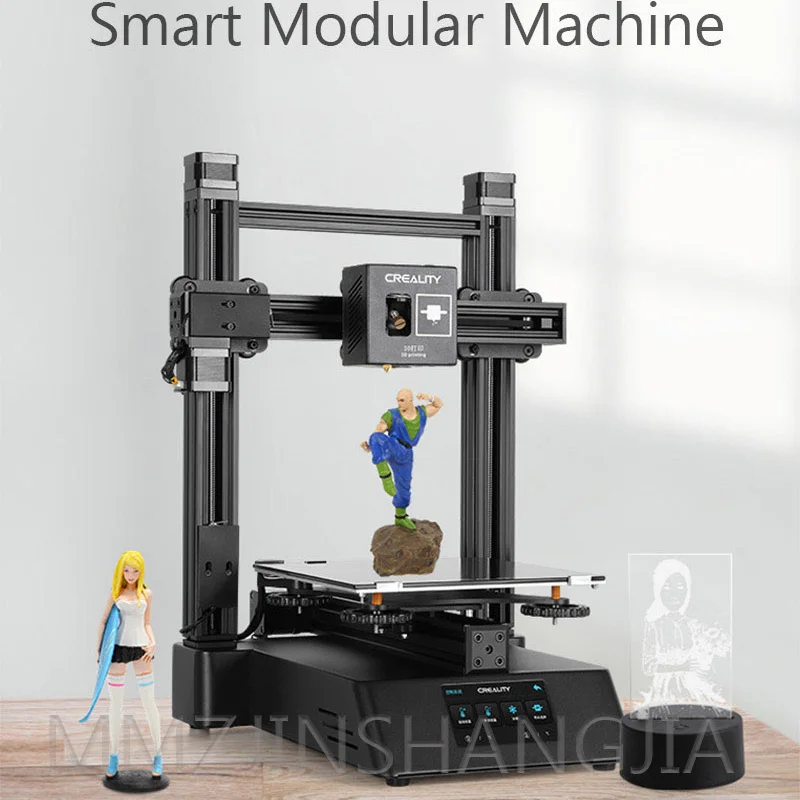 If when printing ABS to connect several parts, you can process the desired areas with acetone, then with PLA you will have to use glue for this purpose. To post-process the surface of the PLA print and make it smooth, you will have to resort to wet grinding: water will prevent the material from heating up from friction and, as a result, its melting.
If when printing ABS to connect several parts, you can process the desired areas with acetone, then with PLA you will have to use glue for this purpose. To post-process the surface of the PLA print and make it smooth, you will have to resort to wet grinding: water will prevent the material from heating up from friction and, as a result, its melting. 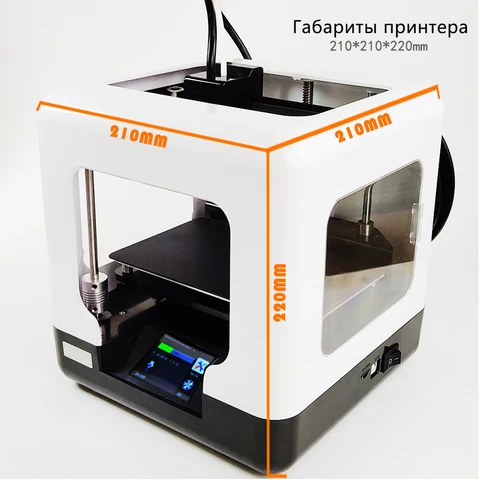
 ABS printouts can be used and stored both indoors and outdoors. It is from ABS plastic that everyone's favorite LEGO constructor is made!
ABS printouts can be used and stored both indoors and outdoors. It is from ABS plastic that everyone's favorite LEGO constructor is made! 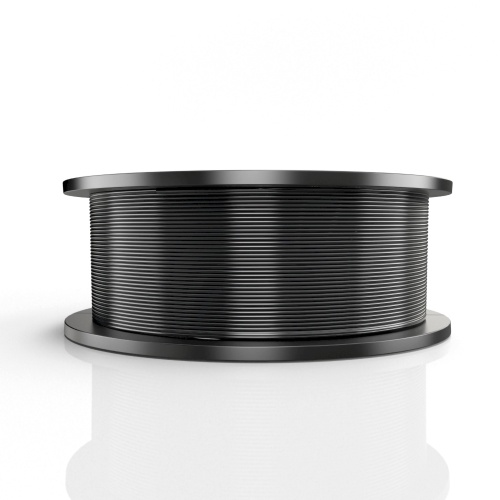 Try to keep the printer in a warm environment when printing from ABS, especially if you are going to print a large model.
Try to keep the printer in a warm environment when printing from ABS, especially if you are going to print a large model. 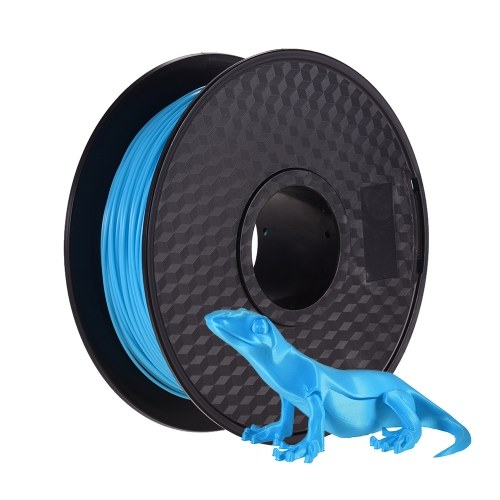

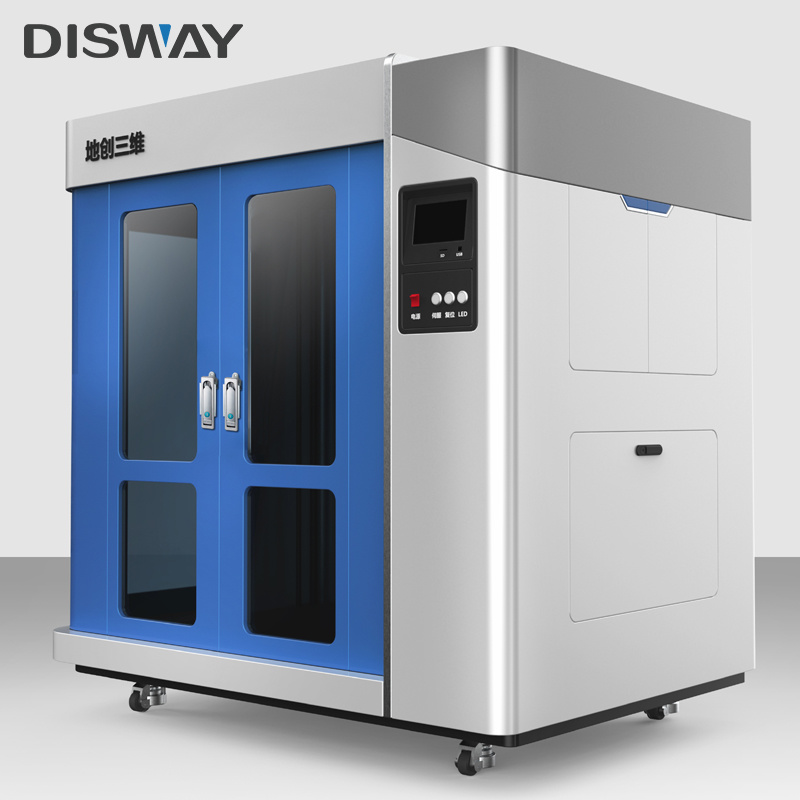
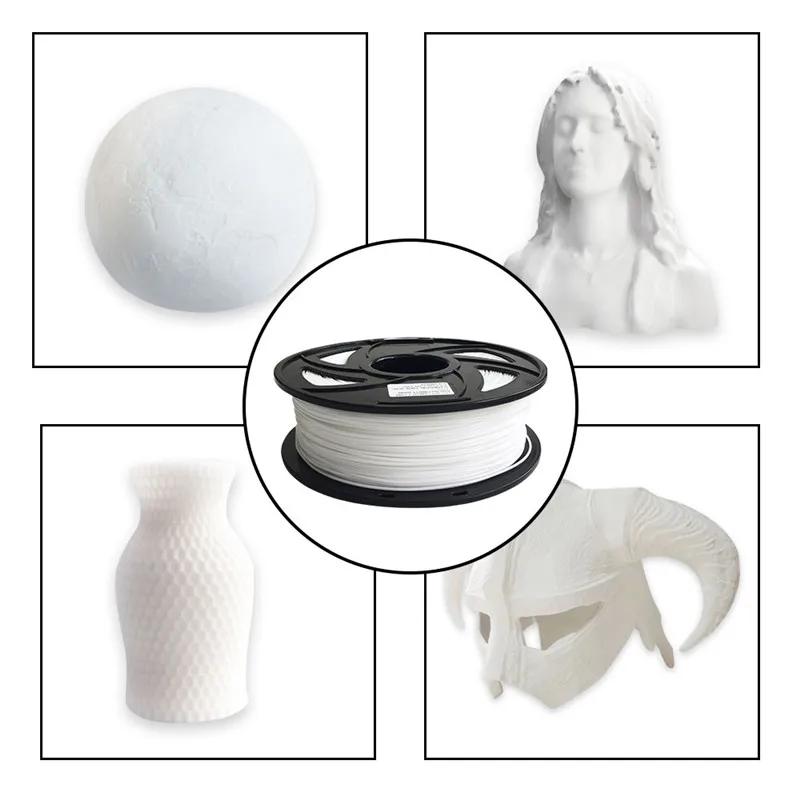 Don't forget to experiment with the print settings in your printer and print and compare samples with different print settings!
Don't forget to experiment with the print settings in your printer and print and compare samples with different print settings! 
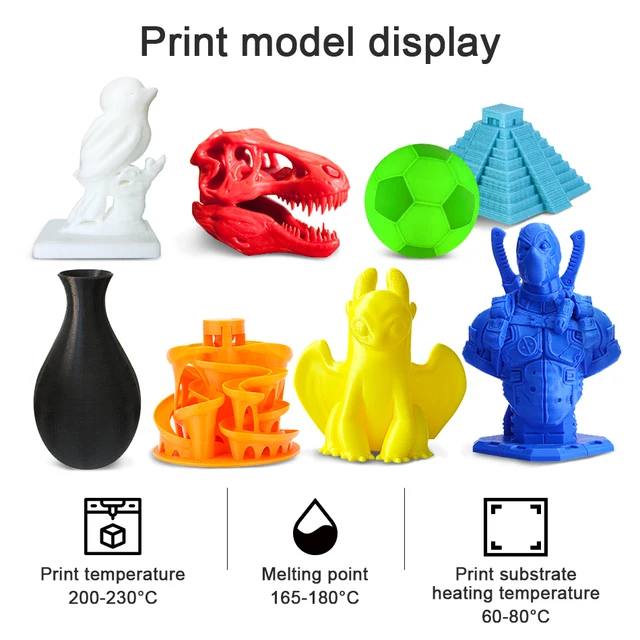 PP printouts are easy to clean due to their resistance to many chemical solvents and acids. However, just because of this chemical resistance of , gluing printouts from polypropylene is practically impossible , so it will be very problematic to combine different parts into a single object.
PP printouts are easy to clean due to their resistance to many chemical solvents and acids. However, just because of this chemical resistance of , gluing printouts from polypropylene is practically impossible , so it will be very problematic to combine different parts into a single object. 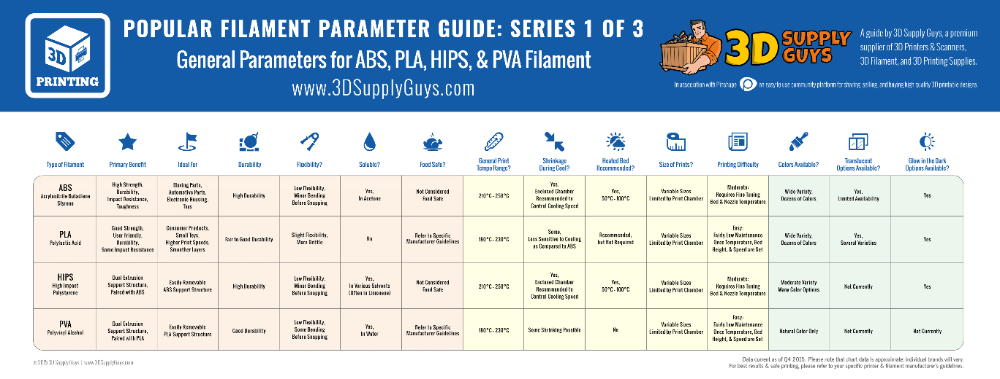 The larger the print object, the higher the platform temperature must be.
The larger the print object, the higher the platform temperature must be. 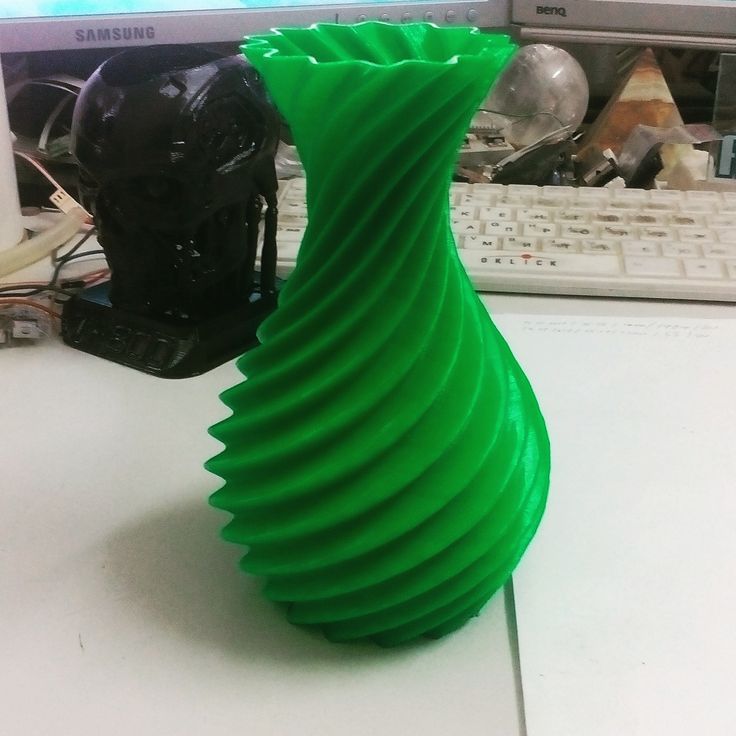 To achieve a smooth surface, you can process printouts with acetone.
To achieve a smooth surface, you can process printouts with acetone. 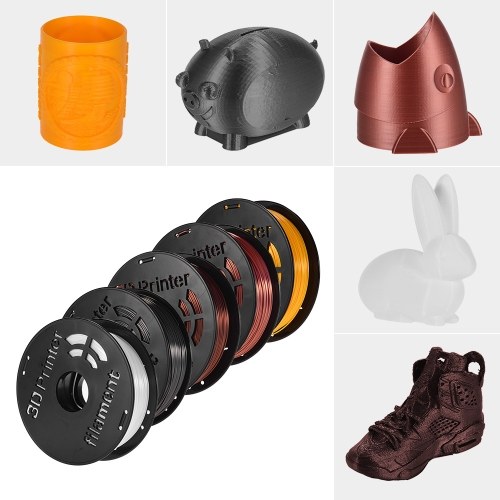
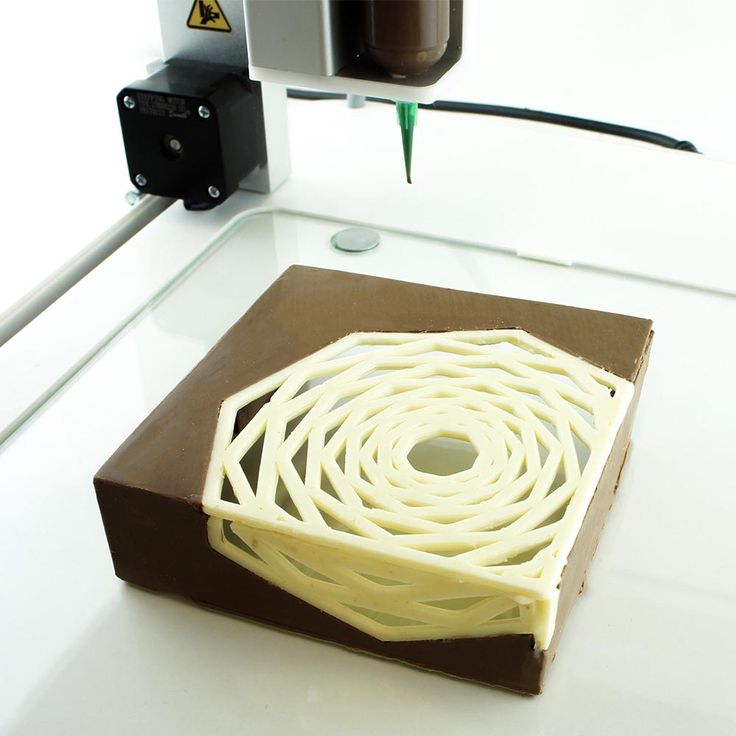
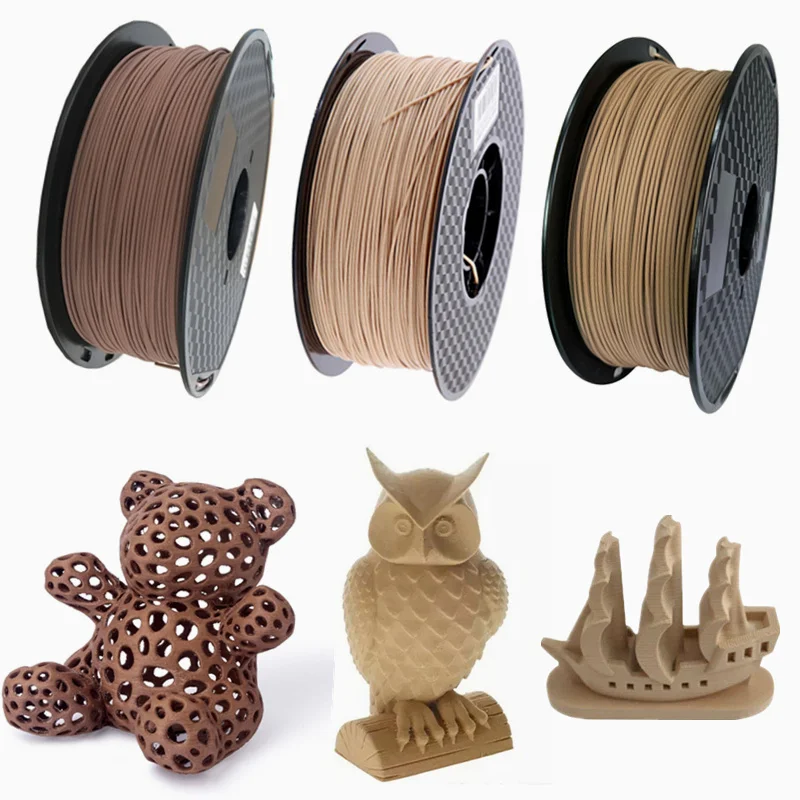
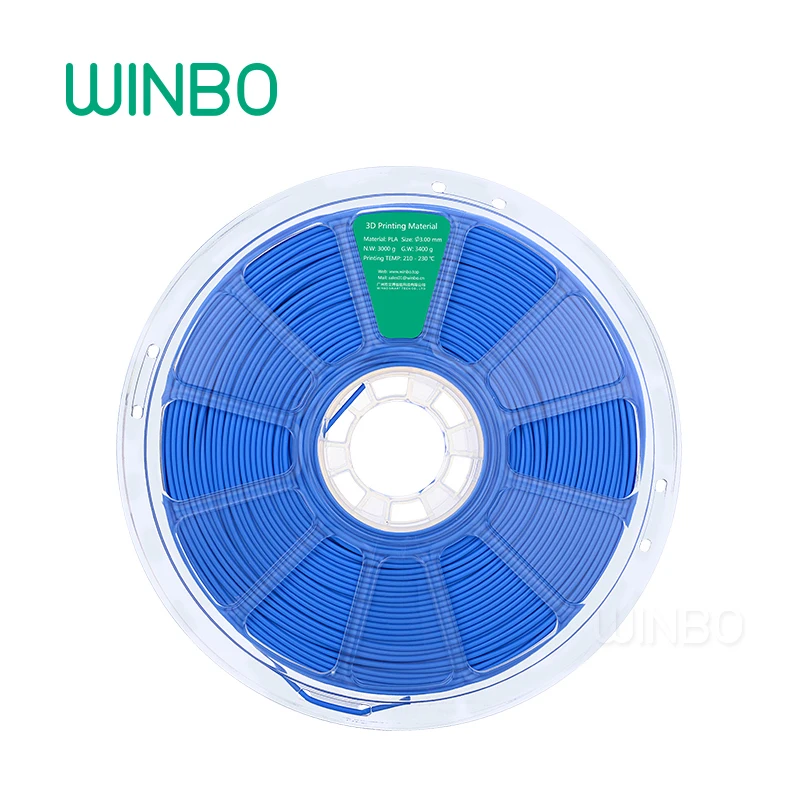 Durable and heat-resistant PC-ABS prototypes perfectly mimic the properties of final products. When printing from PC-ABS, you can create soluble supports to the model, which will allow you to print models with deep cavities.
Durable and heat-resistant PC-ABS prototypes perfectly mimic the properties of final products. When printing from PC-ABS, you can create soluble supports to the model, which will allow you to print models with deep cavities.  Flex layers have a strong grip. Flex has excellent abrasion resistance, remains flexible even at low temperatures and is resistant to many solvents.
Flex layers have a strong grip. Flex has excellent abrasion resistance, remains flexible even at low temperatures and is resistant to many solvents.  When loading Flex filament, loosen the extruder screws. Be aware that when printing from Flex, the automatic filament change function may not work properly.
When loading Flex filament, loosen the extruder screws. Be aware that when printing from Flex, the automatic filament change function may not work properly. 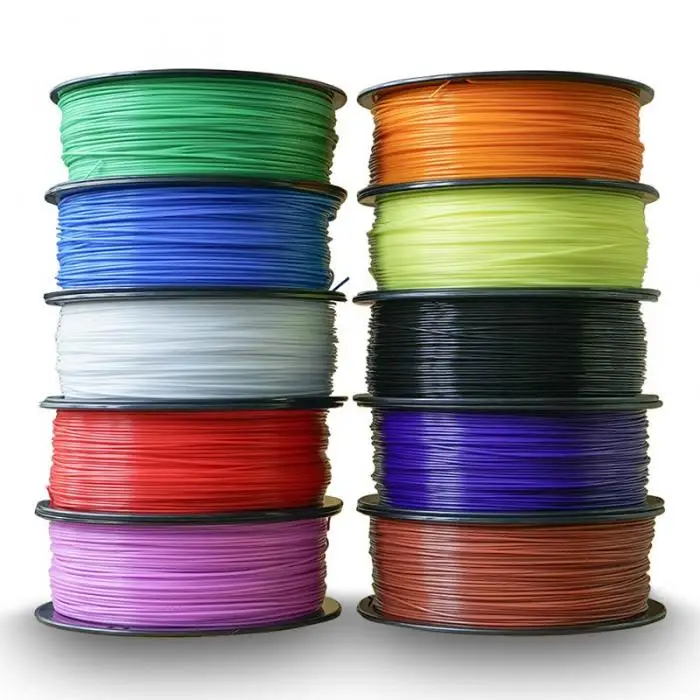 Nylon printouts are quite strong (their strength is comparable to injection molded counterparts). This is because the layers of nylon have excellent grip. Nylon printouts can also be dyed with acid-based dyes.
Nylon printouts are quite strong (their strength is comparable to injection molded counterparts). This is because the layers of nylon have excellent grip. Nylon printouts can also be dyed with acid-based dyes. 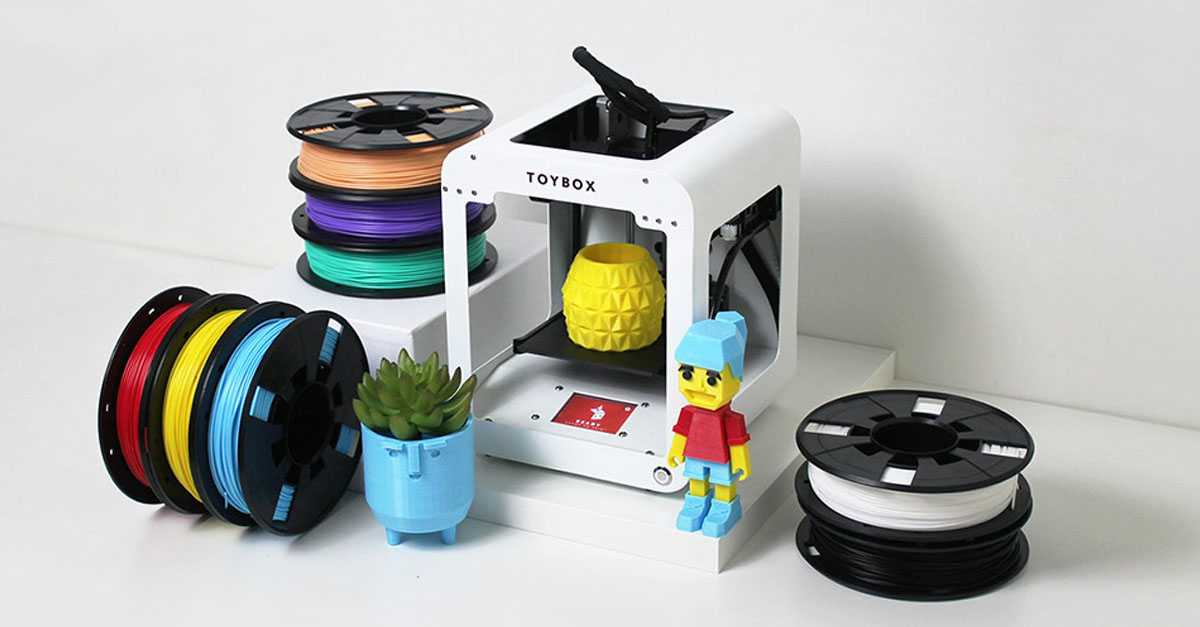
 Composites are plastic-based materials with the addition of an auxiliary powder material : in wood simulants it is microscopic wood chips, in metal simulants it is microparticles of copper or bronze.
Composites are plastic-based materials with the addition of an auxiliary powder material : in wood simulants it is microscopic wood chips, in metal simulants it is microparticles of copper or bronze. 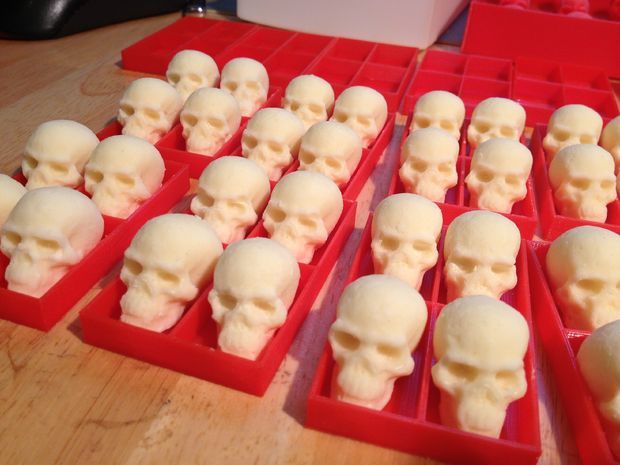 The first step in polishing printouts is sanding: start with coarse sanding (80) and gradually reduce the grit size. For best results after sanding, sanding with a steel wool or copper brush can be used. Wet sanding with very fine grit (1500) can be used to achieve an ultra smooth surface.
The first step in polishing printouts is sanding: start with coarse sanding (80) and gradually reduce the grit size. For best results after sanding, sanding with a steel wool or copper brush can be used. Wet sanding with very fine grit (1500) can be used to achieve an ultra smooth surface. 